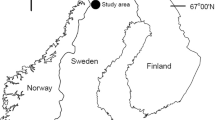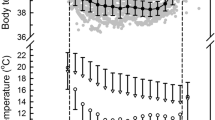Abstract
The distribution of the koala (Phascolarctos cinereus) in Queensland is predicted to contract as a result of climate change, driven by the frequency, intensity and duration of heatwaves and drought. However, little is known about the physiological responses of this species to environmental extremes under field conditions. This study aimed to establish the efficacy of surgically implanted thermal radio transmitters and data loggers to measure the body temperature of free-ranging koalas across a range of environmental conditions and ambient temperatures. Five free-ranging koalas in southeast Queensland were implanted with thermal transmitters and data loggers waxed together as a single package. Body temperatures were recorded for variable periods ranging from 3 to 12 months. Diurnal rhythms in body temperature were detected irrespective of season. The long-term diurnal body temperature peak for all koalas occurred between 16:00 and 17:00 h and body temperature was 36.7–36.9 °C, the long-term nadir occurred between 07:00 and 08:00 h and body temperature was 35.4–35.7 °C. Koala body temperatures as low as 34.2 °C and as high as 39.0 °C were recorded. Thermolability became apparent when ambient temperatures were outside the deduced thermal neutral zone for koalas (14.5–24.5 °C): heat was accumulated during the day and dissipated during the cool of the night. While this study is the first to report on body temperature of free-ranging koalas in their normal behavioural context, further investigations are necessary to determine the physiological boundaries of the thermal niche for this species, in order to better equip models that will more accurately predict the impacts of climate change on koalas.






Similar content being viewed by others
References
Adam D, Johnston SD, Beard L, Nicholson V, Lisle A, Gaughan J, Larkin R, Theilemann P, McKinnon A, Ellis W (2016) Surgical implantation of temperature-sensitive transmitters and data-loggers to record body temperature in koalas (Phascolarctos cinereus). Aust Vet J 94(1–2):42–47. https://doi.org/10.1111/avj.12393
Adams-Hosking C, Grantham HS, Rhodes JR, McAlpine C, Moss PT (2011a) Modelling climate-change-induced shifts in the distribution of the koala. Wildl Res 38(2):122–130. https://doi.org/10.1071/WR10156
Adams-Hosking C, Moss P, Rhodes J, Grantham H, McAlpine C (2011b) Modelling the potential range of the koala at the last glacial maximum: future conservation implications. Australian Zoologist 35(4):983–990. https://doi.org/10.7882/az.2011.052
Aujard F, Vasseur F (2001) Effect of ambient temperature on the body temperature rhythm of male gray mouse lemurs (Microcebus murinus). Int J Primatol 22(1):43–56. https://doi.org/10.1023/a:1026461914534
Briscoe NJ, Handasyde KA, Griffiths SR, Porter WP, Krockenberger A, Kearney MR (2014) Tree-hugging koalas demonstrate a novel thermoregulatory mechanism for arboreal mammals. Biol Lett 10(6). https://doi.org/10.1098/rsbl.2014.0235
Buffenstein R, Woodley R, Thomadakis C, Daly TJM, Gray DA (2001) Cold-induced changes in thyroid function in a poikilothermic mammal, the naked mole-rat. Am J Phys Regul Integr Comp Phys 280(1):R149–R155. https://doi.org/10.1152/ajpregu.2001.280.1.R149
Clifton ID (2010) High koala mortality associated with low browse moisture in tropical environments. Australian Mammalogy 32(2):157–159. https://doi.org/10.1071/AM10015
Clifton ID, Ellis WAH, Melzer A, Tucker G (2007) Water turnover and the northern range of the koala (Phascolarctos cinereus). Australian Mammalogy 29(1):85–88
Cooper CE, Withers PC (2004) Patterns of body temperature variation and torpor in the numbat, Myrmecobius fasciatus (Marsupialia: Myrmecobiidae). J Therm Biol 29. https://doi.org/10.1016/j.jtherbio.2004.05.003
Cooper CE, Withers PC (2012) Does season or captivity influence the physiology of an endangered marsupial, the numbat (Myrmecobius fasciatus)? J Mammal 93(3):771–777. https://doi.org/10.1644/11-mamm-a-084.2
Cooper CE, Withers PC, Munns SL, Geiser F, Buttemer WA (2018) Geographical variation in the standard physiology of brushtail possums (Trichosurus): implications for conservation translocations. Conservation physiology 6(1). https://doi.org/10.1093/conphys/coy042
Crowther MS, Lunney D, Lemon J, Stalenberg E, Wheeler R, Madani G, Ross KA, Ellis M (2014) Climate-mediated habitat selection in an arboreal folivore. Ecography 37(4):336–343. https://doi.org/10.1111/j.1600-0587.2013.00413.x
Dawson TJ, Blaney CE, McCarron HCK, Maloney SK (2007) Dehydration, with and without heat, in kangaroos from mesic and arid habitats: different thermal responses including varying patterns in heterothermy in the field and laboratory. J Comp Physiol B 177(7):797–807. https://doi.org/10.1007/s00360-007-0176-1
Degabriele R, Dawson TJ (1979) Metabolism and heat balance in an arboreal marsupial, the koala (Phascolarctos cinereus). J Comp Physiol A 134(4):293–301. https://doi.org/10.1007/BF00709996
Descovich KA, Johnston S, Lisle A, Nicolson V, Janssen T, Brooks P, Phillips CJC (2017) Long-term measurement of body temperature in the southern hairy-nosed wombat (Lasiorhinus latifrons). Australian Mammalogy 39(1):48–55
Dickens RK (1975) The koala (Phascolarctos cinereus) past, present and future. Aust Vet J 51(10):459–463. https://doi.org/10.1111/j.1751-0813.1975.tb02379.x
Ellis W, Melzer A, Green B, Newgrain K, Hindell MA, Carrick FN (1995) Seasonal variation in water flux, field metabolic rate and food consumption of free-ranging koalas (Phascolarctos Cinereus). Australian Journal of Zoology 43(1):59–68. https://doi.org/10.1071/ZO9950059
Ellis W, Melzer A, Clifton I, Carrick F (2010) Climate change and the koala, Phascolarctos cinereus: water and energy. Aus Zool 35(2):369–377. https://doi.org/10.7882/AZ.2010.025
Ellis W, Bercovitch F, FitzGibbon S, Roe P, Wimmer J, Melzer A, Wilson R (2011) Koala bellows and their association with the spatial dynamics of free-ranging koalas. Behav Ecol 22(2):372–377. https://doi.org/10.1093/beheco/arq216
Ellis W, FitzGibbon S, Pye G, Whipple B, Barth B, Johnston S, Seddon J, Melzer A, Higgins D, Bercovitch F (2015) The role of bioacoustic signals in koala sexual selection: insights from seasonal patterns of associations revealed with GPS-proximity units. PLoS One 10(7):e0130657. https://doi.org/10.1371/journal.pone.0130657
Gaughan JB, Mader TL (2014) Body temperature and respiratory dynamics in un-shaded beef cattle. Int J Biometeorol 58(7):1443–1450
Gaughan JB, Mader TL, Holt SM (2008) Cooling and feeding strategies to reduce heat load of grain-fed beef cattle in intensive housing. Livest Sci 113(2):226–233. https://doi.org/10.1016/j.livsci.2007.03.014
Geiser F (1988) Daily torpor and thermoregulation in antechinus (Marsupialia): influence of body mass, season, development, reproduction, and sex. Oecologia 77(3):395–399
Geiser F (2013) Hibernation. Curr Biol 23(5):R188–R193. https://doi.org/10.1016/j.cub.2013.01.062
Geiser F, Stawski C (2011) Hibernation and torpor in tropical and subtropical bats in relation to energetics, extinctions, and the evolution of endothermy. Integr Comp Biol 51(3):337–348. https://doi.org/10.1093/icb/icr042
Geiser F, Stawski C, Bondarenco A, Pavey CR (2011) Torpor and activity in a free-ranging tropical bat: implications for the distribution and conservation of mammals? Naturwissenschaften 98(5):447–452
Gordon G, Brown AS, Pulsford T (1988) A koala (Phascolarctos cinereus Goldfuss) population crash during drought and heatwave conditions in South-Western Queensland. Aust J Ecol 13(4):451–461. https://doi.org/10.1111/j.1442-9993.1988.tb00993.x
Grigg G, Beard L (2000) Hibernation by echidnas in mild climates: hints about the evolution of endothermy? In: Heldmaier G, Klingenspor M (eds) Life in the cold. Springer, Berlin Heidelberg, pp 5–19
Grigg GC, Beard LA (2001) Application of radio telemetry to studies of the physiological ecology of vertebrates. In: Eiler JH, Alcorn DJ, Neuman MR (eds) 15th international symposium on biotelemetry, vol 15. Thomson-shore, Inc., Juneau, pp 535–551
Grigg G, Kirshner D (2015) Biology and evolution of Crocodylians. CSIRO Publishing, Victoria
Grigg GC, Beard LA, Augee ML (1989) Hibernation in a monotreme, the echidna (Tachyglossus aculeatus). Comp Biochem Physiol A Physiol 92(4):609–612
Grigg GC, Augee M, Beard L (1992a) Thermal relations of free-living echidnas during activity and in hibernation in a cold climate. In: Augee M (ed) Platypus and echidnas. The Royal Zoological Society of NSW, Sydney, pp 160–173
Grigg GC, Beard L, Grant TR, Augee M (1992b) Body-temperature and diurnal activity patterns in the platypus (Ornithorhynchus anatinus) during winter. Aust J Zool 40(2):135–142
Grigg GC, Beard LA, Barnes JA, Perry LI, Fry GJ, Hawkins M (2003) Body temperature in captive long-beaked echidnas (Zaglossus bartoni). Comp Biochem Physiol A Mol Integr Physiol 136(4):911–916
Hahn GL (1999) Dynamic responses of cattle to thermal heat loads. J Anim Sci 77(2):10–20. https://doi.org/10.2527/1997.77suppl_210x
Halse SA, Rose RW (1988) Variation in the basal body temperature of the common brushtail possum (Trichosurus vulpecula) in Tasmania. Mammalia 52(2):225–232. https://doi.org/10.1515/mamm.1988.52.2.225
Krockenberger A (2003) Meeting the energy demands of reproduction in female koalas, Phascolarctos cinereus: evidence for energetic compensation. J Comp Physiol B 173(6):531–540. https://doi.org/10.1007/s00360-003-0361-9
Krockenberger AK, Edwards W, Kanowski J (2012) The limit to the distribution of a rainforest marsupial folivore is consistent with the thermal intolerance hypothesis. Oecologia 168(4):889–899. https://doi.org/10.1007/s00442-011-2146-2
Lunney D, Crowther MS, Wallis I, Foley WJ, Lemon J, Wheeler R, Madani G, Orscheg C, Griffith JE, Krockenberger M, Retamales M, Stalenberg E (2012) Koalas and climate change: a case study on the Liverpool Plains, north-west New South Wales. In: Lunney D, Hutchings PA (eds) Wildlife & climate change: towards robust conservation strategies for Australian fauna. Royal Zoological Society of New South Wales, Mosman, pp 150–168
Martin RW, Handasyde KA, Krockenberger A (2008) Koala. In: Van Dyck S, Strahan R (eds) The mammals of Australia, 3rd edn. Reed New Holland, Sydney, pp 197–201
McAlpine C, Lunney D, Melzer A, Menkhorst P, Phillips S, Phalen D, Ellis W, Foley W, Baxter G, de Villiers D, Kavanagh R, Adams-Hosking C, Todd C, Whisson D, Molsher R, Walter M, Lawler I, Close R (2015) Conserving koalas: a review of the contrasting regional trends, outlooks and policy challenges. Biol Conserv 192:226–236. https://doi.org/10.1016/j.biocon.2015.09.020
McCarron H, Buffenstein R, Fanning F, Dawson T (2001) Free-ranging heart rate, body temperature and energy metabolism in eastern grey kangaroos (Macropus giganteus) and red kangaroos (Macropus rufus) in the arid regions of South East Australia. J Comp Physiol B 171(5):401–411. https://doi.org/10.1007/s003600100189
Nagy KA, Martin RW (1985) Field metabolic rate, water flux, food consumption and time budget of koalas, Phascolarctos Cinereus (Marsupialia: Phascolarctidae) in Victoria. Aust J Zool 33(5):655–665. https://doi.org/10.1071/ZO9850655
Radford SL, McKee J, Goldingay RL, Kavanagh RP (2006) The protocols for koala research using radio-collars: a review based on its application in a tall coastal forest in New South Wales and the implications for future research. Austr Mammal 28(2):187–200
Refinetti R (1999a) Relationship between the daily rhythms of locomotor activity and body temperature in eight mammalian species. Am J Phys Regul Integr Comp Phys 277(5):R1493–R1500. https://doi.org/10.1152/ajpregu.1999.277.5.R1493
Refinetti R (1999b) Amplitude of the daily rhythm of body temperature in eleven mammalian species. J Therm Biol 24(5):477–481
Refinetti R, Menaker M (1992) The circadian rhythm of body temperature. Physiol Behav 51(3):613–637
Riek A, Geiser F (2014) Heterothermy in pouched mammals–a review. J Zool 292(2):74–85
Robinson KW (1954) Heat tolerances of Australian monotremes and marsupials. Aust J Biol Sci 7(3):348–360. https://doi.org/10.1071/BI9540348
Schmidt-Nielsen K, Crawford EC Jr, Newsome AE, Rawson KS, Hammel HT (1967) Metabolic rate of camels: effect of body temperature and dehydration. Am J Phys 212:341–346
Seabrook L, McAlpine C, Baxter G, Rhodes J, Bradley A, Lunney D (2011) Drought-driven change in wildlife distribution and numbers: a case study of koalas in south west Queensland. Wildl Res 38(6):509–524. https://doi.org/10.1071/WR11064
Song X, Geiser F (1997) Daily torpor and energy expenditure in Sminthopsis macroura: interactions between food and water availability and temperature. Physiol Zool 70(3):331–337. https://doi.org/10.1086/639610
Stawski C, Rojas AD (2016) Thermal physiology of a reproductive female marsupial, Antechinus flavipes. Mammal Res 61(4):417–421. https://doi.org/10.1007/s13364-016-0287-8
Sutherland A (1897) The temperatures of reptiles, monotremes and marsupials. Proc R Soc Victoria 9:57–67
Turbill C, Law BS, Geiser F (2003) Summer torpor in a free-ranging bat from subtropical Australia. J Therm Biol 28(3):223–226
Acknowledgements
The authors would like to thank Peter Brice for his invaluable advice and insight into thermal biology. The authors are grateful to Leonie and John at the Hollow Log Country Retreat for allowing us to use their facilities for our research and turning their common room into our field surgery. The authors would also like to thank Samantha Spicer, the veterinary nurse who kindly assisted Dr. Vere Nicolson with surgical procedures.
Author information
Authors and Affiliations
Corresponding author
Additional information
Publisher’s note
Springer Nature remains neutral with regard to jurisdictional claims in published maps and institutional affiliations.
Electronic supplementary material
ESM 1
(DOCX 46.0 kb)
Rights and permissions
About this article
Cite this article
Adam, D., Johnston, S.D., Beard, L. et al. Body temperature of free-ranging koalas (Phascolarctos cinereus) in south-east Queensland. Int J Biometeorol 64, 1305–1318 (2020). https://doi.org/10.1007/s00484-020-01907-y
Received:
Revised:
Accepted:
Published:
Issue Date:
DOI: https://doi.org/10.1007/s00484-020-01907-y




